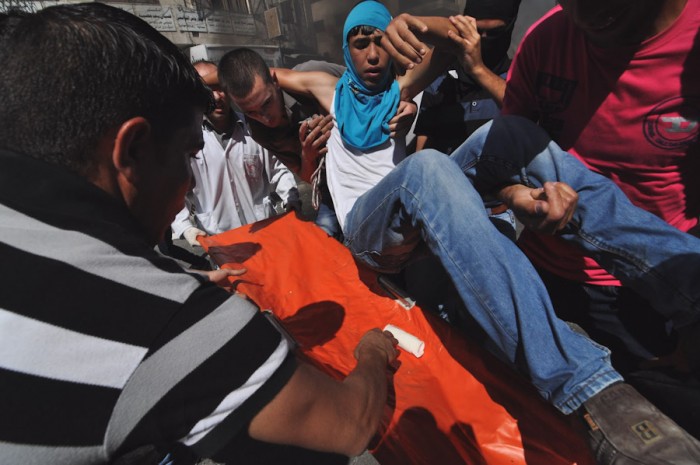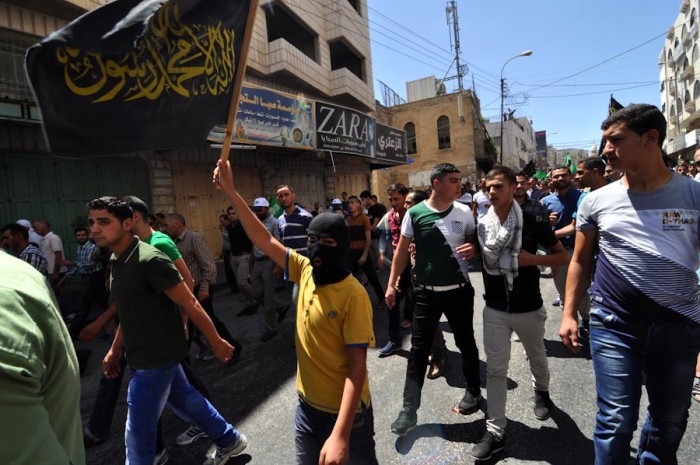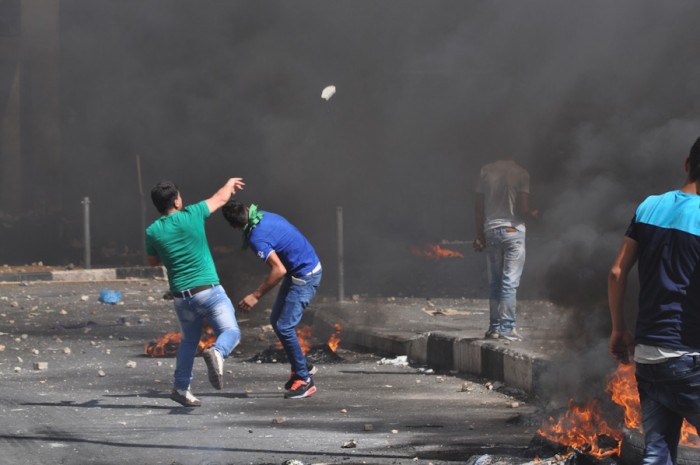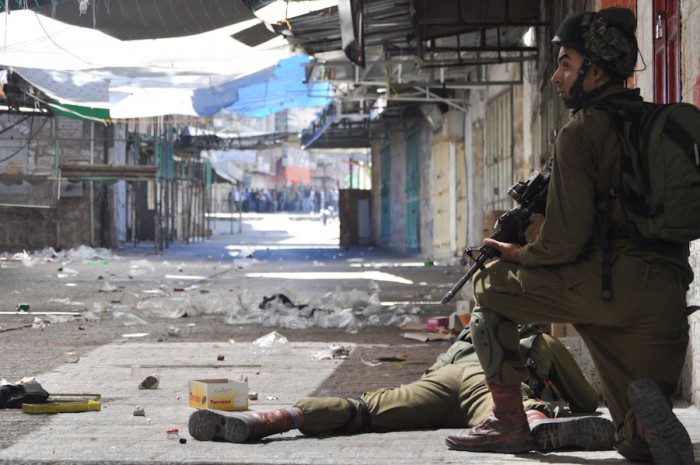
Malek’s mother won’t say whether she knew he was going to the protest, or if he was throwing stones at the Israeli soldiers trying to disperse the crowd there.
It’s easy to see why the family doesn’t want to talk about the protest, or have their last name published. Under Israeli law, throwing stones can bring years in prison and arrests can happen well after the fact. But that’s the least of their worries.
While his mother talks, Malek sleeps, resting after his fourth surgery. At the protest, he was shot. First he was hit in the groin. Then minutes later, as his friends approached to help, he was shot a second time just above his left knee.
“It didn’t just hit the bones,” she says, referring to the second shot. “It smashed them.”
In the surgeries that came after, doctors added screws, then a metal bar, trying to give his leg back some semblance of its shape. Whether he will walk again, or be able to have children (the first bullet struck his genitals) isn’t something they know yet.
In early October the United Nations released a report documenting a surge in shootings like Malek’s. According to witnesses, doctors and rights groups, many come as the result of an extreme crowd control tactic used by the Israeli military, where soldiers are given special rifles to shoot demonstrators in the legs when protests turn violent.
In all, according to the UN figures, at least 757 Palestinians were shot with live ammunition in the West Bank by Israeli forces this summer, as the war raged next door in Gaza.
By comparison, in all of 2013 the UN registered only 161 injuries of civilians from live ammunition in the West Bank.
Often the targets of the shootings were teenagers, almost all participating in the riotous protests that became weekly fixtures during the Gaza war. Some posed clear threats — but others did not, like the 11 year-old boy shot in the back and killed by soldiers in Al Fawar refugee camp, and the 42 year-old father killed in Hebron while he stood, by all accounts empty-handed, in the street.

In one protest shortly before the first of the ceasefires that heralded the end of Operation Protective Edge, local media reported more than 90 injured by live ammunition.
The Israeli Defense Force (IDF) doesn’t deny the tactic. Along with regular military assault rifles, IDF spokeswoman Libby Weiss confirmed in an email that the organization in fact distributes a special .22 caliber weapon specifically for crowd control purposes. According to doctors familiar with its effects, the tactic routinely creates life-threatening injuries, and often leaves survivors with permanent disabilities.
Few of the cases will likely be investigated. According to Weiss, IDF policy calls for automatic investigations of the use of force on civilians only in cases of death, or when the use of force appears to itself to have been a crime. If opened, investigations are handled by the military itself.
Mosa Abu Mashmash, who has worked as an obersever in the West Bank with Israeli human rights organization B’tselem since the start of the second intifiada in 2000, said the recent shootings represent a level of force significantly beyond what was normal in earlier conflicts.
He said that in most cases the shots are fired by soldiers Mashmash describes as snipers, visibly deployed on the rooftops surrounding clashes, and carrying rifles different from the Tavor assault rifles usually carried by soldiers on the ground.
While the Israeli military used live ammunition during the intifadas, he said, the number of shootings in the recent campaign is also a significant break from even that violent norm. Within a month of the start of the recent Gaza military campaign hundreds had been shot in Hebron alone, said Mashmash, whose work includes collecting information on injuries from local hospitals.
“We never had this number [before], not even half of it,” said Mashmash. “There’s no comparison.”
Senior medical staff at two Hebron hospitals independently confirmed Mashmash’s account, portraying a consistent pattern of targets and injuries.
Dr. Hazem Al-Shalaldeh, the general manager of Al Meezan hospital, said staff at his hospital had noted a surge in patients injured by live fire.
The profile, according to Dr. Salah Hashamun, director of Al Ahli hospital: young, often teenaged patients, shot in the legs during protests with bullets that, although small, often do considerable damage.
The main offense of most of those shot, according to data from the UN and human rights organizations who have tracked the violence, has been one that is at once simple and deeply storied in Palestinian history: throwing stones.
For many Palestinians a culturally meaningful gesture, over decades of civil unrest and episodic violence the act of throwing stones has evolved into an affirmation of resistance in the face of the militarily superior Israeli state.

The essentially violent nature of the act, however, complicates the issue, shifting discussion from the appropriate limits of force in dealing with civil unrest to the more subtle issue of proportionality of the response.
Pro-Palestinian activists both in the territory and abroad tend to portray stone-throwing as benign, and throwers themselves as basically unarmed.
The Israeli government takes a different view. Although spokeswoman Weiss wrote that live ammunition from the .22 weapon is intended for use against “the main instigators of riot violence,” it is widely understood that its target is most often stone throwers, who also face two years in prison for the act.
And despite an official position that the Israeli army’s rules of engagement are classified, sections of army rules unearthed during various court proceedings surrounding shootings including in 1993 and during the second intifada treat stone throwers as a mortal danger, to which soldiers may respond with lethal force.
According to Sid Heal, an American expert on policing and civil unrest, thrown stones do pose a real danger, especially when launched from slings, which magnify a projectile’s force and range by allowing a thrower to whirl it in a huge arc before letting fly.
Slings are commonly used in clashes in the West Bank. At a large protest that I witnessed in Hebron in late August, stone-throwing by hand was more common, but the most active throwers — 20 to 30 out of the approximately 100 youths — were easily observed using the simple twine or cord launchers.
Heal, who has advised the US Marine Corps and Department of Defense on non-lethal weapons and crowd control and studied policing tactics in Israel and Northern Ireland, has examined the danger of thrown objects extensively.
While an ordinary person can launch a stone with sufficient force to stun or kill at short range, said Heal in an interview, the same person using a sling can easily throw the same projectile significantly harder — and farther.
That increase in range, Heal said, could be one explanation for the decision to use live ammunition. While non-lethal weapons currently in use have a maximum range of about 150 feet, Heal said, a sling can throw a rock with lethal force more than 180 feet. Viewed in those terms, Heal said, live ammunition from a .22 could be seen as the only way to strike back at attackers without resorting to more powerful standard-duty weapons.
“You can either allow casualties to your own people,” Heal said, “or you can reply in kind.”
The same UN report indicated injuries to at least 48 Israeli soliders or police during the summer, often from stones thrown at protests.

Use-of-force and police tactics expert Steve Ijames offered an alternative explanation for the outsized response — that the live ammunition might be being used at least partly to send a message that will stick.
Ijames, an American, has served as an instructor on crowd control and non-lethal projectiles for the US Department of Justice in Somalia, Haiti, East Timor and Bosnia-Herzgovena.
“It’s one thing to get hit with a water cannon or a plastic bullet, it’s another thing to get shot in the leg with a twenty-two bullet,” Ijames said. “Common sense tells me, with a lot of policing under my belt, that this would be a significant deterrent for most people.”
However effective the strategy might be, Ijames said, it comes with inherent risks. One is of escalating the situation, where by introducing a new level of violence — in this case by introducing firearms — police create an incentive for demonstrators to do the same.
Another is the seductive ease of using more force to create a peace that is ultimately unsustainable.
Inevitably, Ijames said, government authorities have the weapons and backing to physically win almost any conflict with protesters.
“You can exert your will in almost every case, but that may not always be the most long-term productive thing to do,” said Ijames.
If the result is cementing pervasive mistrust and animosity, the result can be that communities become less stable in the long run, not more. In the end, Ijames said, the wrong tactics can actually set the stage for future conflict.
“That’s not winning,” Ijames said.
For Malek, the question of whether he will personally ever attend another protest would seem a narrow measure of the tactic by which he has been crippled. Instead, if the goal is to create a long-term deterrent, the defining question is of how others will react hearing his story – seeing what happened to Malek, will his friends, nephews, and siblings be more or less likely to follow the same path?
The possibility of peace could be tied to the answer. As lopsided conflicts become more and more wars of narrative, a new kind of risk emerges – that of risk not only to life and limb, but to public image.
While a bullet to the leg may keep a few stone throwers off the front lines, in the long run it risks the opposite: feeding the image of the state as an oppressive occupier. More, it risks galvanizing generation after generation of youth who may not themselves remember the sting of punishment, but for whom the brutality of the state — and the rallying cry of rebellion — is viscerally memorialized in the broken bodies of their brothers, uncles, and fathers.


Excellent reporting. An impressive range of credible sources. You’ve documented a startling increase in a particularly vicious kind of force used by the Israeli military against mostly rock-throwing Palestinian teenagers. Your story is also balanced: rocks are dangerous projectiles, and Israeli soldiers can and do suffer serious injuries from them. But ultimately the shattered bones and grievous wounds suffered by kids like Malek, the disproportion of Israeli vs. Palestinian injuries, and the clear prospect that the use of this force does not keep the peace, but poisons it in the long run–all of it challenges Israel to reconsider whether such force is in their self-interest and worth the human suffering it causes.
Well balanced article asking many of the right questions — with a good practical focus on the human requirements all-around. Thanks for the courageous balanced and honest reporting, a nice change.